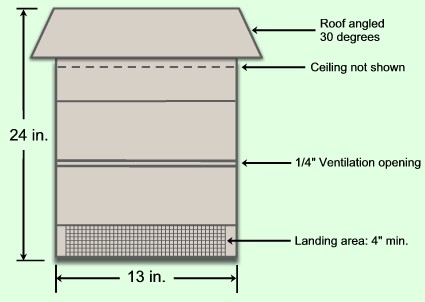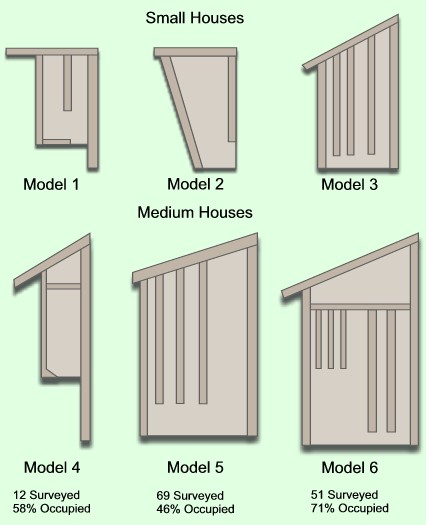|
 
Material List: |
Cedar or exterior plywood
Galvanized screws or nails
1/8-inch plastic mesh
Exterior caulk
Black latex paint
Exterior staples for mesh |
 Bats select larger bat houses over smaller ones, because they are more temperature stable. The longer crevices also provide bats with a greater range of temperatures so that the bats can move up or down to select a comfortable temperature. A recent survey of 276 bat houses across the U.S. by Bat Conservation International revealed that 32% of small houses were occupied, 46% of medium houses held bats, and 71% of larger houses were successful. Bats select larger bat houses over smaller ones, because they are more temperature stable. The longer crevices also provide bats with a greater range of temperatures so that the bats can move up or down to select a comfortable temperature. A recent survey of 276 bat houses across the U.S. by Bat Conservation International revealed that 32% of small houses were occupied, 46% of medium houses held bats, and 71% of larger houses were successful.
 The bat house should be at least 24” H x 13” W x 3” D. The bat house should be at least 24” H x 13” W x 3” D.
 Bat houses should be made of exterior plywood or cedar (rough on the inside). Bat houses should be made of exterior plywood or cedar (rough on the inside).
 Paint or stain the outside of bat houses a dark color (black or dark brown, for ex.) to increase the solar heat gain of the house. Paint or stain the outside of bat houses a dark color (black or dark brown, for ex.) to increase the solar heat gain of the house.
 The inside should have grooves at least every one quarter inch or have polyethylene plastic mesh attached all the way up the front and back. The inside should have grooves at least every one quarter inch or have polyethylene plastic mesh attached all the way up the front and back.
 It can be made with multiple chambers, although this design just has one. The opening at the bottom of the house should be about three fourths to 1 inch. Any larger would allow predators to enter. It can be made with multiple chambers, although this design just has one. The opening at the bottom of the house should be about three fourths to 1 inch. Any larger would allow predators to enter.
 Extend all vertical partitions to within 2 inches of the bottom of the house. This reduces the amount of light reflecting into the crevices & allows more bats to cluster together, making the house temperature more stable. Extend all vertical partitions to within 2 inches of the bottom of the house. This reduces the amount of light reflecting into the crevices & allows more bats to cluster together, making the house temperature more stable.
 It is recommended using 2 inch width sides, then adding a 1 inch strip of wood attached to the lower front panel to create this small opening. It is recommended using 2 inch width sides, then adding a 1 inch strip of wood attached to the lower front panel to create this small opening.
 Caulking the house will keep the bats warm and dry, and putting the bat house together with galvanized screws will help prolong the life of the house. Adding a ceiling at the top of the house just below the roof, and leaving a one fourth inch space about 6 inches from the bottom opening, will create much-needed temperature variation. Caulking the house will keep the bats warm and dry, and putting the bat house together with galvanized screws will help prolong the life of the house. Adding a ceiling at the top of the house just below the roof, and leaving a one fourth inch space about 6 inches from the bottom opening, will create much-needed temperature variation.
 When building a bat house with an attic, make the opening to the attic at least 1 1/4 inches opening stretches across all the crevices on the cooler side of the house (this depends on where you place the house). Secure floor by nailing. When building a bat house with an attic, make the opening to the attic at least 1 1/4 inches opening stretches across all the crevices on the cooler side of the house (this depends on where you place the house). Secure floor by nailing.
 Houses can be mounted on poles, garages, barns, human houses, or trees, making sure there are no obstacles to prevent the bats from entering the bat house. Trees usually take longer to become occupied because bats find the houses by sight and if the leaves of the tree are covering the bat house, it is harder to find. When mounting a bat house on a post or a tree, attach a 2 ft. wide aluminum sheet or sheet metal below the house to prevent climbing predators. Paint the predator guard with dark paint to reduce glare into the crevices, and enlarge the guard periodically on trees to accommodate the tree's growth. Houses can be mounted on poles, garages, barns, human houses, or trees, making sure there are no obstacles to prevent the bats from entering the bat house. Trees usually take longer to become occupied because bats find the houses by sight and if the leaves of the tree are covering the bat house, it is harder to find. When mounting a bat house on a post or a tree, attach a 2 ft. wide aluminum sheet or sheet metal below the house to prevent climbing predators. Paint the predator guard with dark paint to reduce glare into the crevices, and enlarge the guard periodically on trees to accommodate the tree's growth.
 Your house needs to be placed at least 15 feet up, the higher the better, and should face a south to southeasterly direction with at least 6 hours of sunlight daily. If your house is not getting at least 6 hours of sunlight you may want to paint it using a nontoxic black paint (never paint the inside of the house). Your house needs to be placed at least 15 feet up, the higher the better, and should face a south to southeasterly direction with at least 6 hours of sunlight daily. If your house is not getting at least 6 hours of sunlight you may want to paint it using a nontoxic black paint (never paint the inside of the house).
 When placing something on the ground below the bat house to catch the guano, do not use white or light-colored materials because these will reflect too much light into the house. When placing something on the ground below the bat house to catch the guano, do not use white or light-colored materials because these will reflect too much light into the house.
Below are some general plans for common bat houses.

|

